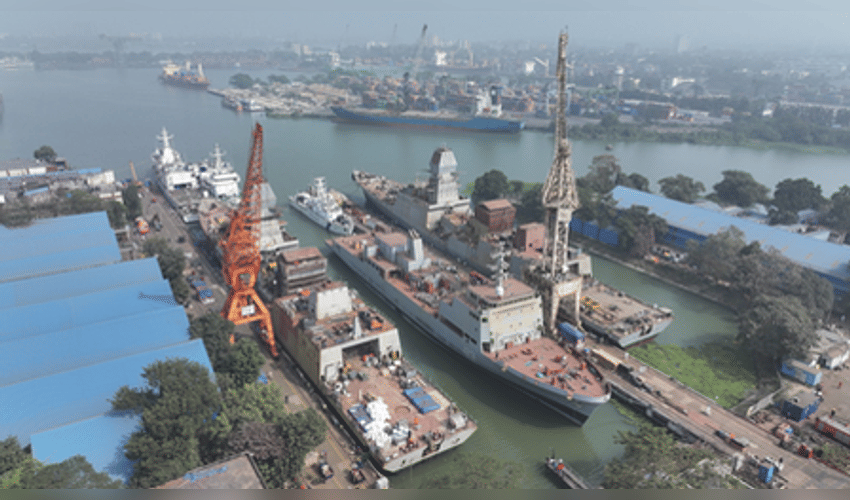Asia In News
India sailing ahead with over Rs 3 lakh crore Maritime Vision 2030
Published On Sun, 26 Oct 2025
Asian Horizan Network
1 Views

New Delhi, Oct 26 (AHN) Charting a decade of transformation, from 2014 to 2025, India’s maritime sector is cruising ahead with a record performance across ports, coastal shipping, and inland waterways, according to an official statement issued on Sunday ahead of the India Maritime Week 2025, which kicks off in Mumbai on Monday.
The development is powered by Maritime India Vision 2030, backed by a total investment of Rs 3-3.5 lakh crore to modernise ports, expand shipping capacity, and strengthen inland waterways. A recent landmark package of Rs 69,725 crore is under implementation to boost shipbuilding and revitalise the maritime ecosystem.
India’s ports sector has witnessed a transformative leap, with total port capacity nearly doubling from 1,400 million metric tonnes per annum (MMTPA) to 2,762 MMTPA, reflecting major investments in modernisation and infrastructure.
The sector’s financial strength has surged, with the net annual surplus rising sharply from Rs 1,026 crore to Rs 9,352 crore, underscoring improved revenue generation and cost management, the statement said.
Efficiency indicators have also strengthened, with the operating ratio improving from 73 per cent to 43 per cent, marking a major step toward sustainable and profitable port operations.
Cargo handling volumes have grown impressively from 972 million metric tonnes (MMT) to 1,594 MMT, signalling robust growth in maritime trade and port efficiency, with major ports handling approximately 855 million tonnes of cargo in FY 2024-2025, an increase from 819 million tonnes in FY 2023-24.
Operational performance has improved significantly, as the average vessel turnaround time has been reduced from 93 hours to just 48 hours, enhancing overall productivity and global competitiveness.
India’s shipping sector has charted steady growth, with the number of Indian-flagged vessels rising from 1,205 to 1,549, reflecting the nation’s expanding maritime presence.
The gross tonnage of the Indian fleet has increased from 10 million gross tonnes (MGT) to 13.52 MGT, underscoring a stronger and more capable shipping capacity.
Coastal shipping has gained significant momentum, with cargo movement nearly doubling from 87 million metric tonnes (MMT) to 165 MMT, reinforcing the shift toward efficient, low-cost, and eco-friendly transport modes.
In a landmark development for the inland water transport sector, the Inland Waterways Authority of India (IWAI) reported a record cargo movement of 146 MMT in 2025, up from 18 MMT in 2014, an increase of around 710 per cent.
The number of operational waterways has increased remarkably from 3 to 29, reflecting a major boost to India’s inland transport network.
IWAI handed over the Haldia Multi-Modal Terminal (MMT) to IRC Natural Resources, marking a major step in advancing inland waterway infrastructure and promoting multimodal logistics under the Public-Private Partnership (PPP) model. Built with World Bank’s assistance, the West Bengal terminal has a capacity of 3.08 million metric tonnes per annum (MMTPA).
Ferry and Ro-Pax (a ship that carries both vehicles and passengers) have also gained strong traction, carrying over 7.5 crore passengers in 2024-25, reflecting growing public adoption of water-based transport for safe and efficient travel.
In just a decade, India’s seafarer workforce has surged from 1.25 lakh to over 3 lakh, now accounting for 12 per cent of the global seafaring workforce, making the country one of the world’s top three suppliers of trained seafarers and opening up vast opportunities in navigation, ship operations, logistics, and allied maritime industries at home and overseas.
With a Rs 25,000 crore corpus, the Maritime Development Fund (MDF) is set to provide long-term financing to expand India’s shipping tonnage and shipbuilding capacity. Complementing this, the revamped Shipbuilding Financial Assistance Scheme, with an outlay of Rs 24,736 crore, tackles domestic cost disadvantages and incentivises ship-breaking, while the Shipbuilding Development Scheme drives greenfield clusters, yard expansions, and risk coverage with Rs 19,989 crore.
India Maritime Week 2025 (IMW 2025) is a landmark event in the global maritime calendar, taking place from October 27 to 31 at the NESCO Exhibition Centre, Mumbai. Bringing together key stakeholders from the shipping, port, and logistics communities, IMW 2025 will serve as a strategic platform for dialogue, collaboration, and business development. The event is expecting participation from over 100 countries and drawing more than 1,00,000 delegates, port operators, investors, innovators, and policymakers alike. The five-day programme will feature 500 exhibitors, thematic pavilions, technology demonstrations, and sessions spanning port-led development, shipbuilding clusters, and digital corridors.



